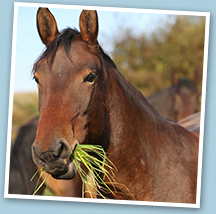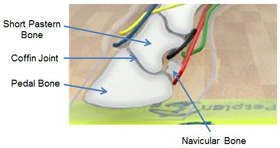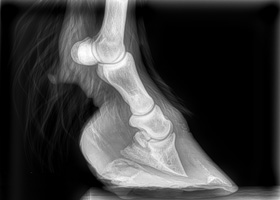
Laminitis
Petplan Equine is warning horse owners to be extra vigilant when it comes to Laminitis. We paid out claims for
Laminitis in each of the 12 months of 2014, amounting to a total of just under £370,000.
A greater understanding of Laminitis in horses means year-round management that makes prevention increasingly possible.
Petplan Equine’s veterinary expert Gil Riley explains the condition, what causes it, the symptoms to look out for and how to determine whether
your horse is at risk.

Diagram of a horse’s hoof
What is Laminitis?
Laminitis is a most common painful and debilitating condition affecting horses and ponies in the UK. Laminitis means inflammation of the laminae. The laminae are soft tissue structures found in the foot. They lie between the horn and the pedal bone and their purpose is to provide a secure attachment between these two vital structures. Inflammation of these laminae causes profound pain and greatly undermines their strength which means the pedal bone can rotate within the hoof capsule and even, in the worst cases, sink (or “founder”), a life-threatening situation.
Symptoms of Laminitis
Laminitis causes a profoundly lame horse with heat and increased digital pulses in the affected feet. Sometimes it is so distressingly severe that the affected animal cannot stand and must lie down constantly.
What are the causes of Laminitis?
The mechanism by which Laminitis occurs has been the topic of enormous research over the last twenty years and our knowledge of how it happens, and in turn how we can prevent it, has truly undergone a revolution. Once associated only with the times of the year with better grass, we must now consider it a year round threat and must remain vigilant at all times. The causes historically talked about still remain very true and include:
- Stress
- Concussion to the hoof
- Obesity
However veterinary science has now shown there are two more prevalent causes:

X-ray taken of a pony’s hoof suffering from Laminitis
Hormonal Mechanisms
We have always known that sudden intake of high sugar food can predispose to Laminitis but it is only now we can explain through the actions of hormonal mechanisms why this should be so.
- Obese animals are prone to a condition called “Insulin resistance” which is described as Equine Metabolic Syndrome (EMS).
- Insulin is the hormone that instructs cells to take up glucose from the blood; in days gone by, due to the paucity of available food, animals would thin over the autumn and winter before putting weight on again in the better times of the year.
- With the supplementary feeding we now perform over the darker months, animals kept in excessively good condition have a constantly high glucose.
- In turn there is a constant secretion of insulin and in some of these cases the animals cells simply cease to respond to it; i.e. they become resistant.
- The body produces even more insulin in a vain attempt to lower the blood glucose and these increased levels of glucose can have adverse effects on the blood supply to and within the laminae which leads to Laminitis.
Treatment for Equine Metabolic Syndrome (EMS)
There are a number of drugs which can be helpful, however ultimately there can only be a long term cure in such cases if the animal loses significant weight.
Cushings Disease
Another very important hormonal disease that frequently causes Laminitis is Cushings disease. Cushings is a result of a dysfunction in the Pituitary gland of the brain resulting in excess amounts of steroid in the body.
- The high levels of steroid produced by the Pituitary Gland can affect circulation to the feet and result in Laminitis.
- Cushings is mainly a condition of older animals although we are aware now that much younger animals can be affected.
- Often the animal’s appearance can betray the presence of Cushings- the pituitary is responsible for the release of other hormones besides the one leading to steroid production and one of these causes hair growth.
- Horses can have a “woolly” coat besides unusual fat deposits, vulnerability to infection and of course Laminitis.
Testing for Cushings
A reliable blood test now exists as does a reliable treatment so a condition that in the past was once basically a death sentence has been transformed into something we can more often than not manage very well.
How to determine whether your horse is at risk
- Monitor the diet and your horse’s condition regularly. Use a weight tape, take pictures for records on your mobile phone.
- Condition score on a fortnightly basis paying particular attention to the fat laid down around the crest of the neck which has been strongly linked to Laminitis risk.
- And finally, if still concerned, talk to your feed supplier/dietary advisor and your Vet- they will be able to advise on diet, management and perform the appropriate tests that will allow treatment to be commenced before Laminitis strikes.



